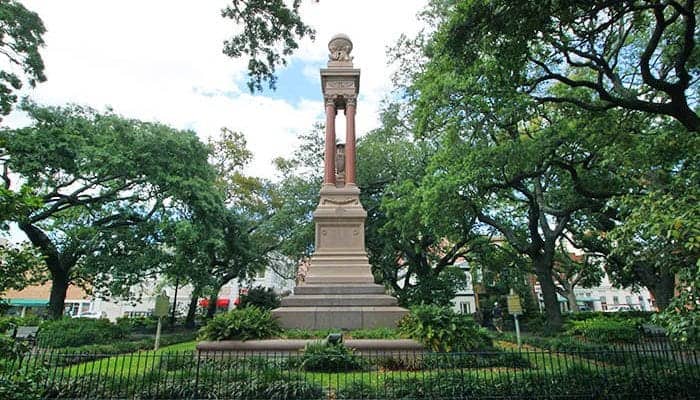
Savannah TourPass
You can view Featured Tour availability prior to purchasing a pass
(Does not show times for Standard Attractions that you can visit anytime during their operating hours)
Savannah’s second square, Wright Square, was laid out in 1733. Originally named Percival Square, the square was later re-named Wright Square to honor the last Royal Governor of Georgia, Sir James Wright. Home to the city’s courthouse since Savannah’s earliest days, locals frequently refer to the area as “Court House Square.” In Oglethorpe’s day, Wright Square was the legal center of the Georgia colony, and a bustling hub of activity as the site for not only trials, but hangings, public auctions, and the reading of public announcements and decrees. In 1739, Wright Square gained the distinction of being the first of Savannah’s squares to be marked by a monument.
WRIGHT SQUARE GHOST – ALICE RILEY – Unlike many other reported ghost sightings, quite a few details are known about Wright Square’s resident haunt, the young Alice Riley. Ms. Riley was an indentured servant, cruelly mistreated by her master, William Wise. Much is known about the conditions of Ms. Riley’s servitude, including the fact that Mr. Wise required Alice and her husband to bathe him daily, and that he sexually assaulted the young woman. Desperate to be free, Alice and her husband drowned Mr. Wise in his bath and fled the city in March of 1734. Apprehended on the Isle of Hope, the couple was returned to Savannah for hanging. Alice’s husband was hung first, but when it was Alice’s turn she plead for mercy and for the life of her unborn child. It was discovered she was carrying Mr. Wise’s child and she languished in prison until the birth of her infant. In January of 1735, a crowd watched as Alice Riley was dragged onto the gallows, screaming for her newborn baby. She was quickly hanged, and her body was left on display for days. Sadly, her infant child died only 45 days later. Reports of Alice Riley’s ghost span hundreds of years, and it is said that the spirit most often appears to expectant mothers, or women with young children, searching for her baby. Interestingly, you will see little Spanish Moss growing in Wright Square, while it is found in abundance in other areas of the city. Locals offer up this oddity as evidence of Alice’s story. Native American lore tells us that Spanish Moss cannot grow where innocent blood has been spilt.
See map below for address
The Tour Pass for Charleston was so easy to use to get into all the attractions on the list and customer service was quick to respond and very kind. I would definitely purchase again!
I was so happy with this package/ I was informing all the Uber Drivers so they could tell people about it! Not many people we ran into knew about this deal. Check it out- we did so many things - tours, horse drawn tours- boat tours- multiple entrances to wonderful historical places. Definite win!
We purchased the 2 day tour for Charleston and were so glad we did! The 3 premium tours we picked were excellent and we had fun adding the standard tours where we could fit them in. An excellent value. I would highly recommend it.
I was just scrolling on facebook when an add jumped out at me. I was planning a trip to Savannah and trying to figure out what all to do while my family was there. TourPass was a great find because you pay one time and can do multiple things in a day. They have so many options and many of them are must see/do tours so it worked out great. We really enjoyed all the tours we booked through TourPass and the app was very easy to use. I would definitely recommend using it if you’re traveling to any of the cities there are in.
We did three tours, the hop on hop off trolley tour, the guided riverboat ride and the haunted pub crawl. All were easy to find, had great narrators/tour guides and were just a lot of fun. We will definitely return soon!
The horse drawn carriage tour of Charleston was a fantastic experience, our guide Ian along with his sidekick Chester did a wonderful job! We would highly suggest this tour!!
The kayaking experience was a different in that there was not a calming experience through the Marina, you had to jockey around boats and fisherman lines heading out into open water, it was quite busy with both of those issues. This tour was okay.
Great way to see the town! One pass with sooo many options. We went on our favorite tour with this pass. Savannah Port Tour! We got to see so much in a day. Easy to use as well. We had no problems checking into any tour or house. Another good thing about the pass…. Not sure we would have known about all these options without the pass! Many thanks!
I purchased the Tour Pass for two people for 2 days. We started early each day and tried to experience as many opportunities as we could. Using it was super easy and we saved money over the individual admission prices. I highly recommend!
This pass was great. I was able to take multiple tours and they were all included in the price. I will defiantly use this option again when traveling.
We got the 4 day pass and spent 1 full week in Charelston. We scheduled 4 featured tours for each night/day and filled in the rest of the time with the amazing standard tours. It made our stay a great time. I recommend this pass.
We live in Jacksonville and regularly in St. Augustine for day trips or long weekends. Tour Pass was fantastic to use during a recent long weekend visit. We booked the two-day pass to take advantage of our favorite attractions with the added benefit of trying some new things we had not visited in the MANY trips to the Old City. Unfortunately, a hurricane forced the closure of many attractions in the middle of the day on Day 2 but an email to Tour Pass was quickly responded to and offered a great solution. We loved the opportunity to revisit some attractions we had seen before and were excited to experience some for the first time. We could squeeze in quite a few in the one and a half days . We were looking forward to using Tour Pass on our next visit to Savannah!
The tour pass was awesome! We had so much to do and it was very easy and convenient to use. Definitely worth purchasing. You really end up saving money. I wish they would have more than three days max. I would definitely purchase more days. It was a wonderful trip!
Tour guide was very knowledgeable! Pass was a great savings and allowed us to do a lot more things.
Tour Pass was very convenient. Places had my name when I arrived. Didn't have to buy tickets
Just showed my passed and I was in. Got alot for the money. I bought 3 day pass. Used it those 3 days in Charleston.
Me and my besties took advantage of the one day pass! Wow did we get our money’s worth! We didn’t get to do everything, but out of the stops we did visit, really worth the price!! I def recommend! Probs would do it again too!! Ha! Loved it, and such a great time visiting St. Auggie! ;)

Pass purchases can be refunded (minus 3% credit card processing fees) if requested within thirty-days of purchase date (for unused passes). Optional Trip Insurance can be purchased for a nominal fee at checkout which extends the refund period up to one-year from purchase date. Conditions apply. View full refund policy by clicking button below.